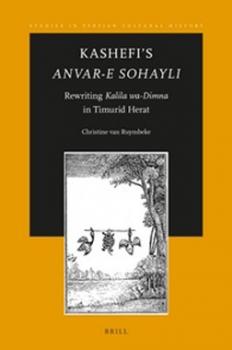Monograph on Va’ez Kashefi’s Anvar-e Sohayli
This research has already resulted in a series of essays on the Persian versions of the Kalila and Dimna stories and a monograph on the Anvar-e Sohayli, a fifteenth-century rewriting done in Timurid Herat (Kashefi’s Anvar-e Sohayli: Rewriting Kalila and Dimna in Timurid Herat, Brill, 2016). The monograph analyses the contents, style and rewriting techniques of the Anvar-e Sohayli, by the polymath Va’ez Kashefi. This text has suffered over a century of virulent criticism both by academics in Iran and in the West, despite its interest and impact as an example of “rewriting and misreading”. This is also a text of immense rhetorical intricacy. The research looks at the history of the fables’ rewriting in Persian, at the political and psychological contents of the fables and at the particular importance given to rhetoric in this version. Interest for the Kalila wa Dimna in Arabic is revived and the above publications will flag the seminal importance of the Persian sources for the Arabic field.
Publication on the Persian versions of Kalila and Dimna
Related to this just-published monograph, research has started towards a further publication on other, equally forgotten, Persian rewritings of the fables: The sixteenth-century Mughal statesman Abu’l-Fazl is the author of ‘Iyar-e Danesh, the Touchstone of Knowledge, which is described in secondary literature as a simplified prosimetric version of Anvar-e Sohayli. It is not edited, nor translated, nor studied. Two other unstudied Persian Kalila and Dimna versions, a masnavi by Qane’i, the other, a prose text by Bokhari, together with the better-known bi-lingual prosimetrum by Nasrollah Monshi, will be discussed in the light of literary rewriting theories.

